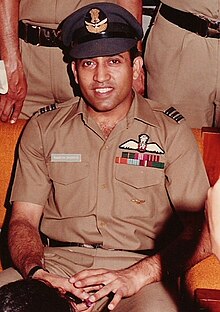Rakesh Sharma
| Rakesh Sharma | |
|---|---|

Rakesh Sharma
|
|
| Nationality | Indian |
| Status | Retired |
| Born |
13 January 1949 Patiala, Punjab, India |
|
Other occupation
|
Test pilot at the Indian Air Force |
| Rank |
|
|
Time in space
|
7d 21h 40m |
| Selection | 1982 |
| Missions | Soyuz T-11 / Soyuz T-10 |
|
Mission insignia
|
|
| Awards |
Hero of the Soviet Union |
Rakesh Sharma, AC, Hero of the Soviet Union, (born 13 January 1949) is a former Indian Air Force pilot who flew aboard Soyuz T-11, launched April 2, 1984, as part of the Intercosmos programme. Sharma was the first Indian to travel in space.
Rakesh Sharma was born on 13 January 1949 in Patiala, Punjab, India. He attended St. Georges Grammar School, Hyderabad. He graduated from Nizam College. He joined the Air Force as a cadet in 1966 at the age of 18. Thereafter, he was admitted to the National Defence Academy as an Air Force plebe in July 1966. Rakesh proved to be a focused and dedicated student and by 1970, he was commissioned into the Indian Air Force to become a pilot.
An alumnus of the 35th National Defence Academy, Rakesh Sharma joined as a test pilot in the Indian Air Force in 1970. He flew various Mikoyan-Gurevich (MiG) aircraft starting from 1971. Rakesh Sharma swiftly progressed through many levels and in 1984 he was appointed as the Squadron Leader and pilot of the Indian Air Force. He was selected on the twentieth of September in 1982 to become a cosmonaut and go into space as part of a joint program between the Indian Space Research Organisation (ISRO) and the Soviet Intercosmos space program.
In 1984, he became the first Indian citizen to enter space when he flew aboard the Soviet rocket Soyuz T-11 launched from Baikonur Cosmodrome in Kazakh Soviet Socialist Republic on the second of April 1984. The Soyuz T-11 docked and transferred the three member Soviet-Indian international crew which also included the Ship's Commander Yury Malyshev and Flight Engineer Gennadi Strekalov (USSR) to the Salyut 7 Orbital Station. Sharma spent 7 days 21 hours and 40 minutes aboard the Salyut 7 during which his team conducted scientific and technical studies which included 43 experimental sessions. His work was mainly in the fields of bio-medicine and remote sensing. The crew held a joint television news conference with officials in Moscow and then Indian Prime Minister Indira Gandhi. When Indira Gandhi asked Sharma how India looked from outer space, he replied Saare Jahan Se Achcha (the best in the world). This is the title of a patriotic poem by Iqbal that had been written when India was under British colonial rule, that continues to be popular today. India became the 14th nation to send a man to outer space.
...
Wikipedia
